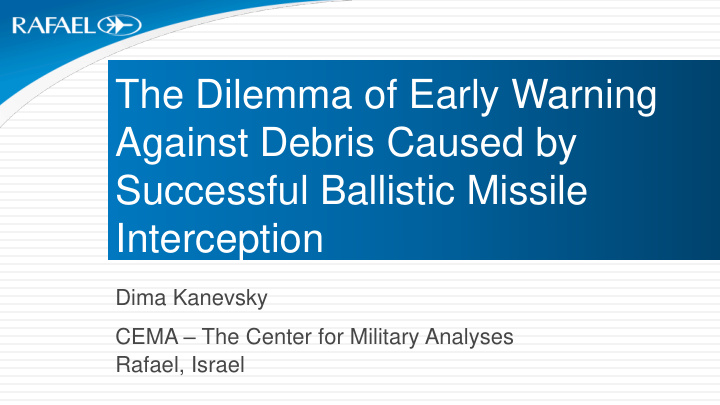



The Dilemma of Early Warning Against Debris Caused by Successful Ballistic Missile Interception Dima Kanevsky CEMA – The Center for Military Analyses Rafael, Israel
Unclassified General Since the year 2001 Israel has sustained more than 16,000 rockets 18,000 Iron Dome is an Anti-Missile Air Defence System which is operational since April 2010 and has shot down more than 500 rockets with a success rate of over 86% 1,000 90% 2 29/7/2014
Unclassified Background The role of Anti-Missiles Air Defence Systems in military operations is steadily increasing Every successful interception is followed by falling debris Some of the debris might endanger people below the interception point 3 29/7/2014
Unclassified 4 29/7/2014
Unclassified Main Dilemma This (new) situation evokes the question: Disturbance of the Is early warning life routine against interception debris essential? Life-saving 5 29/7/2014
Unclassified Goals Estimate the risk to the Recommend ways to update the population on the ground: early warning policy based on research results Calculate the limits of debris ’ danger area Is early warning against interception debris essential? Calculate the time during which the danger persists If so, where should this warning be given? Estimate of casualty numbers in case no early warning is given How should people be warned? What instructions should be given to the population? This paper discusses lower tier intercepts only (up to 15-20 km) 6 29/7/2014
Unclassified Method Threat Type Distribution Interception Height Time of Fall Model Wind Profile On-Ground Distribution Map Expected Number of Casualties Early Population Density Vulnerability Warning Model Policy Exposed Population Additional Total Population Considerations 7 29/7/2014
Unclassified Threat Type Distribution Interception Height Time of Fall Model Wind Profile On-Ground Distribution Map Expected Number of Casualties Early Population Density Vulnerability Warning Model Policy Exposed Population Additional Total Population Considerations 8 29/7/2014
Unclassified Single Fragment Trajectory 80 70 60 Short, not affected Height 50 by wind 40 30 Long, 20 affected by 10 wind 0 Ground distance 9 29/7/2014
Unclassified Homogeneous Fragmentation Cloud Fragment mass - 5 gram, Height - 3000 m 300 Side view Top view 300 200 200 100 Vertical distance, m Ground distance, m 100 0 -100 0 -200 -100 -300 -200 -400 -300 -500 -400 -300 -200 -100 0 100 200 300 400 -300 -200 -100 0 100 200 300 Horizontal distance, m Ground distance, m 10 29/7/2014
Unclassified Drifting 10 0 10 -1 10 -2 10 -3 10 -4 10 -5 10 -6 10 -7 Falling time – up to several minutes 11 29/7/2014
Unclassified Simplified Approach Validation Downwind distance, m 12 29/7/2014
Unclassified Threat Type Distribution Interception Height Time of Fall Model Wind Profile On-Ground Distribution Map Expected Number of Casualties Early Population Density Vulnerability Warning Model Policy Exposed Population Additional Total Population Considerations 13 29/7/2014
Unclassified Vulnerability Model = Probability of Casualty Person Ratio of Fragments Population Presented Exposed * * * Density Density Area Population 10 -4 10 -6 = 10 -8 Expected Probability Number of of dx dy 10 -10 Casualties Casualty 10 -12 14 29/7/2014
Unclassified Criterion for Dangerous Fragment Currently measured by amount of kinetic energy or kinetic energy per cross-section area A fragment approaches the ground with a constant (terminal) velocity, which is a function of its mass Hence the criterion can be formulated in terms of fragment ’ s mass 15 29/7/2014
Unclassified Risk Estimation Fragment Mass steel stone Expected Impact Risk Level (Terminal ball £1 ball Velocity) Minor Injury – scratch, 0-2 grams No risk (40 miles/h) limited bleeding Minor to Moderate 2-5 grams Low (50-100 miles/h) Injury Moderate to Serious 5-10 grams Medium (55-110 miles/h) Injury Serious to Severe above 10 grams High (60-120 miles/h) Injury 16 29/7/2014
Unclassified Who Needs to be Warned? Below concrete roof Below non-concrete roof Unprotected Inside a car 100 grams 50 grams Unprotected persons should find the nearest shelter (concrete roof) Persons in a car should stop and remain inside Persons inside a building should do nothing 17 29/7/2014
Unclassified Expected Number of Casualties (real-time calculation) Medium-sized warhead, Salvo of 5 small warheads, Total expected number of Total expected number of casualties – 5 10 -3 casualties – 3 10 -2 10 -4 10 -4 -4 N N 10 -6 10 -6 -6 10 -8 10 -8 -8 10 -10 10 -10 -10 2 2 10 -12 km km 10 -12 -12 18 29/7/2014
Unclassified Conclusions Dangerous free falling fragments weigh 2 grams and more The expected number of casualties is about 1/100 per intercept The dangerous area might be very large Early warning is not always essential (night, wartime) 19 29/7/2014
Recommend
More recommend